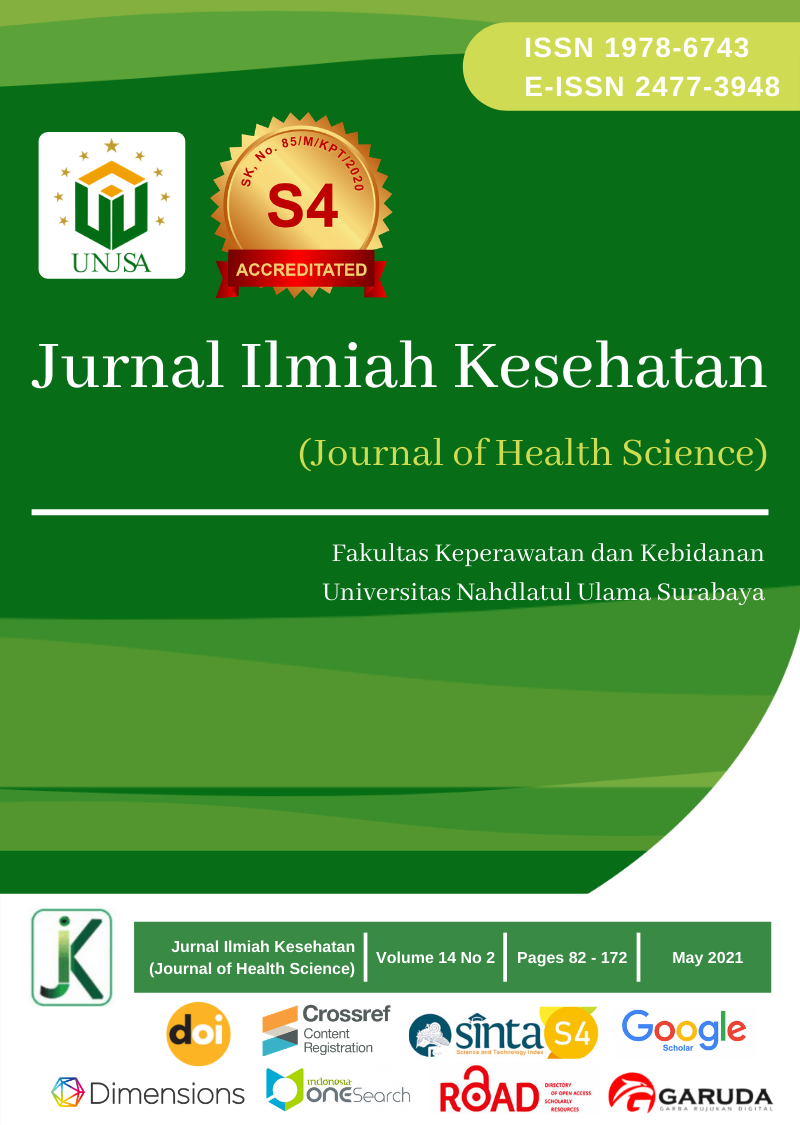Bacterial Identification And Antibiotics Sensitivity Of Ventilator-Associated Pneumonia (VAP) Patients At RSD Dr. Soebandi Jember
Main Article Content
Abstract
Ventilator-Associated Pneumonia (VAP) is pneumonia in patients who use mechanical ventilator. The empirical antibiotic therapy is given to VAP patients based on bacterial mapping and its antibiotic sensitivity. The aim of this study is to determine bacterial identification and antibiotic sensitivity of VAP patients at RSD dr. Soebandi Jember. This study is a retrospective study, the data collected from medical record of VAP patients from September to October 2019. All samples that is meet the inclusion and exclusion criteria was recruited in this study. Data analysis was use Microsoft Excel 2010. This study obtained 15 samples. The most frequents bacteria that causes VAP is Acinetobacter baumanii. It is also caused by Klebsiella pneumoniae, Pseudomonas aeruginosa, Enterobacter aerogenes, Burkholderia cepacia, Pseudomonas fluorescence, Salmonella arizonae, and Escherichia coli. The bacteria are most sensitive to amikacin, meropenem, and piperacillin-tazobactam and most resistant to cefixime, cefotaxime, and ceftriaxone.
Downloads
Article Details
Copyright (c) 2021 Muhammad Ali Shodikin, Mira Haninda Ramadhanty, I Nyoman Semita

This work is licensed under a Creative Commons Attribution-ShareAlike 4.0 International License.
References
Barbier F, Andremont A, Wolff M, Bouadma L. Hospital-acquired pneumonia and ventilator-associated pneumonia: recent advances in epidemiology and management. Current Opinion in Pulmonary Medicine. Mei 2013;19(3):216–28.
Bayram M, Babalik M, Bakan ND, Döngel İ. Community-acquired Burkholderia cepacia pneumonia: a report of two immunocompetent patients. Tuberk Toraks. 2011;59(4):380-3.
Brunton, L, Parker K, Blumenthal D, dan Buxton L. Goodman & Gilman’s Manual of Pharmacology and Therapeutic. NewYork: McGrawHill;2008.
Cilloniz C, Martin-Loeches I, Garcia-Vidal C, San Jose A, Torres A. Microbial Etiology of Pneumonia: Epidemiology, Diagnosis and Resistance Patterns. IJMS. 16 Desember 2016;17(12):2120.
Dahlan, Zul. 2014. Ilmu Penyakit Dalam Jilid 2. Edisi 6. Jakarta: Interna Publishing.
Donnenberg, MS. Mandell, Douglas, and Bennett’s Priciples and Practice of Infectious Disease. 8th Edition. Philadelphia: Elshevier; 2015.
El Chakhtoura NG, Bonomo RA, Jump RLP. Influence of Aging and Environment on Presentation of Infection in Older Adults. Infectious Disease Clinics of North America. Desember 2017;31(4):593–608.
Falagas ME, Mourtzoukou EG, Vardakas KZ. Sex differences in the incidence and severity of respiratory tract infections. Respiratory Medicine. September 2007;101(9):1845–63.
Gadani H, Vyas A, Kar A. A study of ventilator-associated pneumonia: Incidence, outcome, risk factors and measures to be taken for prevention. Indian J Anaesth. 2010;54(6):535.
Garneau-Tsodikova S, Labby KJ. Mechanisms of Resistance to Aminoglycoside Antibiotikas: Overview and Perspectives. 2016;15.
Hardman, J.G. dan L.E. Limbird. Goodman & Gillman Dasar Farmakologi Terapi. Edisi 10. Vol. 3. Jakarta: Penerbit Buku Kedokteran EGC;2012.
Harris AM, Bramley AM, Jain S, Arnold SR, Ampofo K, Self WH, dkk. Influence of Antibiotikas on the Detection of Bacteria by Culture-Based and Culture-Independent Diagnostic Tests in Patients Hospitalized With Community-Acquired Pneumonia. Open Forum Infectious Diseases 2017;4(1).
Howard A, O’Donoghue M, Feeney A, Sleator RD. Acinetobacter baumannii: An emerging opportunistic pathogen. Virulence. Mei 2012;3(3):243–50.
Hunter JD. Ventilator associated pneumonia. BMJ. 29 Mei 2012;344(may29 1):e3325–e3325.
Ito I, Kadowaki S, Tanabe N, Haruna A, Kase M, Yasutomo Y, dkk. Tazobactam/piperacillin for moderate-to severe pneumonia in patients with risk for aspiration: Comparison with imipenem/cilastatin. Pulmonary Pharmacology & Therapeutics. Oktober 2010;23(5):403–10.
Kalanuria AA, Zai W, Mirski M. Ventilator-associated pneumonia in the ICU. 2014;8.
Kalil AC, Metersky ML, Klompas M, Muscedere J, Sweeney DA, Palmer LB, dkk. Management of Adults With Hospital-acquired and Ventilator-associated Pneumonia: 2016 Clinical Practice Guidelines by the Infectious Diseases Society of America and the American Thoracic Society. Clinical Infectious Diseases. 1 September 2016;63(5):e61–111.
Lee Y-C, Hung M-C, Hung S-C, Wang H-P, Cho H-L, Lai M-C, dkk. Salmonella enterica subspecies arizonae infection of adult patients in Southern Taiwan: a case series in a non-endemic area and literature review. BMC Infect Dis. Desember 2016;16(1):746.
Mandell, LA dan Wunderink RG. Harrison’s Principles of Internal Medicine. 19th edition. United State: The McGraw-Hill Companies; 2015.
Paterson DL. Resistance in Gram-Negative Bacteria: Enterobacteriaceae. The American Journal of Medicine. Juni 2006;119(6):S20–8.
Ruppé É, Woerther P-L, Barbier F. Mechanisms of antimicrobial resistance in Gram-negative bacilli. Ann Intensive Care. Desember 2015;5(1):21.
Scales BS, Dickson RP, LiPuma JJ, Huffnagle GB. Microbiology, Genomics, and Clinical Significance of the Pseudomonas fluorescens Species Complex, an Unappreciated Colonizer of Humans. Clin Microbiol Rev. Oktober 2014;27(4):927–48.
Schweiger J, Karlnoski R, Mangar D, Kolla J, Munoz G, Thompson P, dkk. Impact of a Low-Pressure Polyurethane Adult Endotracheal Tube on the Incidence of Ventilator-Associated Pneumonia: A before and after Concurrence Study. ISRN Critical Care. 2013;2013:1–6.
Shindo Y, Ito R, Kobayashi D, Ando M, Ichikawa M, Shiraki A, dkk. Risk Factors for Drug-Resistant Pathogens in Community-acquired and Healthcare-associated Pneumonia. Am J Respir Crit Care Med. 15 Oktober 2013;188(8):985–95.
Zander, D.S. dan C.F. Farver. Pulmonary Pathology. 2nd Edition; 2018.





